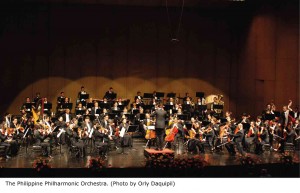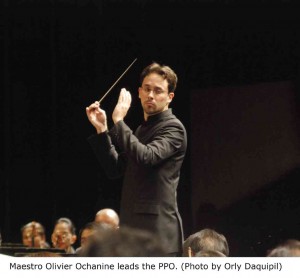
The Philippine Philharmonic Orchestra awed Manila’s music-lovers in the concluding performance of its season concert held recently at the Main Theater of the Cultural Center of the Philippines.
The orchestra literally ended its concert season with a bang through an engaging performance of Mahler’s gigantic Fifth Symphony.
Mozart’s overture to “Cosi Fan Tutte” and Liszt’s Piano Concerto No. 2 in A Major, featuring young pianist Gabriel Allan Paguirigan, completed the program.
The programming followed the standard format with the overture and the concerto played in the first part and Mahler’s grand symphonic work capping the concert in the second part.
Scored for a big orchestra, Mahler’s Fifth Symphony is of epic proportions. Long as it is, it engages the listeners to pleasurable listening that makes them forget time.
The work is a huge canvas of different moods associated with death, love, merriment and the like, all expressed in luxuriant colors and arresting sonorities.
Gruesome colors

The country’s premier orchestra was ably led by its dynamic conductor, maestro Olivier Ochanine. His youthful look was betrayed by a mature disposition, keen eye for detail, and thorough familiarity of the work, which ensured outstanding performance. He wielded his baton with authority.
At once the audience was mesmerized by Fredeline Parin’s (principal, trumpet) rendition of the opening theme. Handsomely, the winds, first the brasses and later the woodwinds, brilliantly evoked the grim beat of the funeral march.
After the bugle call, a huge canvas of gruesome symphonic colors towered to engage full listening, dismounting later through a whimper, a pointed pizzicato by the strings.
In the agitated second movement, the cellos essayed a silken tone in a variant of the funeral theme. Equally impressive were the brasses that essayed a brilliant chorale. The grim ambiance of this movement easily ties it to the first movement.
Regarded as introduction, these two movements comprise the first part of this three-part symphonic work; the third movement being the second part, and the fourth and fifth movements being the third part.
Time for merriment
The long pause was devoted to tuning the instruments. The third section (second part), the scherzo, was a time for merriment, as the inspired maestro and the musicians played a festive, if rustic, scherzo, built on the pomposity of the waltz beat.
Following the maestro’s active cues certainly enabled the listener to follow the unfolding of the music.
Then came the cue for the solo horn played eloquently by Jay-Ar Mesa. It certainly was a coup de grâce, an absorbing highlight.
Undaunted, the young soloist etched his line handsomely in flawless intonation. For sure his playing added a haunting, if noble, color to the movement that heightened its sylvan ambiance.
Then the most awaited adagietto came, and it certainly conquered! What velvety tone the strings etched!
Lourdes de Leon Gregorio, PPO’s veteran harpist, provided equal verve. Together, they rendered one of the most touching movements of a symphonic work, expressing Gustav Mahler’s lofty adoration of his beloved wife Alma.
Symphonic might
Truly a song without words, the movement was the soul of the work: a most tender declaration of love exquisitely expressed through mellow singing of the harp and the strings.
The final movement was played with vivacity. Here, one followed once more the conductor’s active hands, defining those contrapuntal cues. All the more the listeners had a grand moment of heightened listening!
The brilliant chorale of the whole brass section was a catchy highlight. The music surged to great heights to elicit momentous listening in jubilant mood. And when the strings sounded in unison, the work had come to an end.
The listeners, truly awed, did not notice they had been listening for quite a long time, a little over an hour. Applause was deafening; the PPO once more had asserted its symphonic might!
Upbeat
Even in the earlier two works that started with Mozart’s overture, the orchestra was already on the upbeat mood.
In Mozart, the lines were clearly etched true to the classical mould. In Liszt’s Piano Concerto No. 2, young pianist Gabriel was given the opportunity to collaborate with the orchestra.
Offstage, it was learned the pianist had earlier emerged as winner of an audition, conceptualized by Ochanine himself, precisely to provide exposure to budding musical talents.
The pianist showed dexterity, and given the proper exposure he would surely hone his potential to become a formidable concert pianist.

